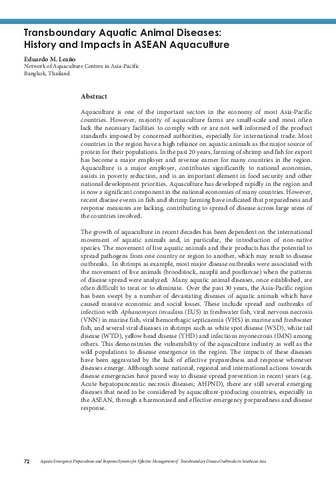Current status, issues, and gaps on aquatic emergency preparedness and response systems practiced by Cambodia
- Global styles
- MLA
- Vancouver
- Elsevier - Harvard
- APA
- Help

วันที่
2019Page views
8,840ASFA keyword
disease control 
disease recognition
disease resistance
disease transmission
epidemiology
husbandry diseases
aquaculture regulations
quarantine regulations
fishery regulations
safety regulations
response time
emergencies
fishing effort
marine fisheries
food security
fish
aquaculture development
capacity building
inspection
inland water environment
management
aquaculture
natural resources
vulnerability
enforcement
research
legislation
countries
stocks
mariculture
sea water
fresh water
fishing
diseases
aquatic animals
catch-effort

disease recognition

disease resistance

disease transmission

epidemiology

husbandry diseases

aquaculture regulations

quarantine regulations

fishery regulations

safety regulations

response time

emergencies

fishing effort

marine fisheries

food security

fish

aquaculture development

capacity building

inspection

inland water environment

management

aquaculture

natural resources

vulnerability

enforcement

research

legislation

countries

stocks

mariculture

sea water

fresh water

fishing

diseases

aquatic animals

catch-effort

AGROVOC keyword
เมตาดาต้า
แสดงระเบียนรายการเต็ม
Share
นามธรรม
A few decades ago, Cambodia was rich in both freshwater and marine fisheries resources because of its favorable geographical area. However, the fisheries resources have depleted and were unable to totally fulfill the increasing fish demands of its people. This was caused by various factors including unfavorable climate changes, increase in population, improper agricultural production practices, and other human affecting activities. In this sense, aquaculture development in Cambodia becomes increasingly important in order to reduce the fishing pressure on its natural resources which are mainly for food security and economy of Cambodian people. Aside from this, aquatic animals in the country are vulnerable to infectious aquatic transboundary diseases as a result of insufficient and low transboundary diseases monitoring capacity. Neither the official list of aquatic transboundary diseases was created nor are the emergency preparedness and response systems for effective management of transboundary disease outbreaks in Cambodia has been well-established. Nonetheless, the government fisheries officers of both central and provincial levels have conducted fish health monitoring and undertake sample collection from fish farmers since 2016 in 10 targeted provinces as funded by the European Union s Programme. Regarding the capacity of the diagnostic laboratory, officers can perform level I and II but not for all species and diseases. Level III diagnoses cannot be effectively performed yet due to the lack of facilities, skills, and knowledge. The Marine Aquaculture Research and Development Center (MARDeC) is the only main laboratory for aquatic animal health diagnosis in the country. To minimize the spread of aquatic transboundary diseases in freshwater and seawater, the Ministry of Agriculture, Forestry and Fisheries has been moving to initiate and establish policies regarding: (1) the registrations, licensing, and law enforcement; (2) the inspection of sites; (3) and the issuance of health certificate and quality seals. However, those national regulations and legislation regarding the movement of aquatic animal stocks are not yet practical or effective. Importantly, the Royal Government of Cambodia needs both technical and financial assistance. It requires an improvement, amendment, and enforcement of the regulations, laws and the standard operating procedures (SOPs). It requires laboratory capacity building and SOPs for responsible management to establish the aquatic emergency preparedness and response systems for effective management of transboundary disease outbreaks in Cambodia as well as Southeast Asia.
การอ้างอิง
Khan, C. D., Chhorn, S., & Thay, S. (2019). Current status, issues, and gaps on aquatic emergency preparedness and response systems practiced by Cambodia. In E. A. Tendencia, L. D. de la Peña, & J. M. V. de la Cruz (Eds.), Aquatic Emergency Preparedness and Response Systems for Effective Management of Transboundary Disease Outbreaks in Southeast Asia: Proceedings of Asean Regional Technical Consultation, 20-22 August 2018, Centara Grand Central Ladprao, Bangkok, Thailand (pp. 7-11). Tigbauan, Iloilo, Philippines: Aquaculture Department, Southeast Asian Fisheries Development Center.
Type
Conference paperISBN
9789719931089
Related items
Showing items related by title, author, creator and subject.
-
Country status of aquatic emergency preparedness and response systems for effective management of aquatic animal disease outbreaks in Myanmar
Oo, Kyaw Naing; Cho, Yi Yi (Aquaculture Department, Southeast Asian Fisheries Development Center, 2019)Myanmar is one of the OIE members and the Department of Fisheries (DoF) is highly concerned with transboundary aquatic animal pathogens. Therefore, the Aquatic Animal Health & Disease Control Section has already been ... -
Transboundary aquatic animal diseases: History and impacts in ASEAN aquaculture
Leaño, Eduardo M. (Aquaculture Department, Southeast Asian Fisheries Development Center, 2019)Aquaculture is one of the important sectors in the economy of most Asia-Pacific countries. However, majority of aquaculture farms are small-scale and most often lack the necessary facilities to comply with or are not well ... -
Aquatic emergency preparedness and response system in Viet Nam
Bui, Viet-Hang T.; Nguyen, Viet-Nga T.; Nguyen, Lan-Huong T.; Nguyen, Hien T.; Pham, Quan H.; Vo, Chuong D.; Nguyen, Tien N. (Aquaculture Department, Southeast Asian Fisheries Development Center, 2019)Viet Nam is one of the top worldwide producers of aquaculture products which accounts for about 22 percent of total agricultural GDP of Viet Nam. Recently, diseases have become the biggest challenge for global aquaculture ...




